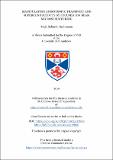Files in this item
Manipulating anisotropic transport and superconductivity by focused ion beam microstructuring
Item metadata
| dc.contributor.advisor | Mackenzie, Andrew | |
| dc.contributor.advisor | Moll, Philip Johannes Walter | |
| dc.contributor.author | Bachmann, Maja Deborah | |
| dc.coverage.spatial | xiii, 191 p. | en_US |
| dc.date.accessioned | 2019-06-11T08:34:32Z | |
| dc.date.available | 2019-06-11T08:34:32Z | |
| dc.date.issued | 2019-06-24 | |
| dc.identifier.uri | https://hdl.handle.net/10023/17866 | |
| dc.description.abstract | This thesis presents the results of electrical transport experiments performed on two microstructured quantum materials, namely on the ultra-pure metal PdCoO₂ and on the heavy fermion superconductor CeIrIn₅. Throughout this work, focused ion beam (FIB) microsculpting was utilised to design the investigated devices. I begin with an introduction to the FIB instrument, with a specific focus on its application for microstructuring transport devices from quantum materials. In particular, our standard fabrication procedure, in which a thin slab of material is extracted from a bulk single crystal for further processing is described in detail, as this approach can be utilised for most metallic compounds. Furthermore, I describe a micro-fabrication process for creating transport devices from platelet-shaped single crystals. Thereafter I present ballistic transport measurements of the ultra-pure delafossite metal PdCoO₂. By investigating mesoscopic transport bars which are narrower than the electron mean free path (up to 20 μm), I demonstrate that the ballistic transport in PdCoO₂ is strongly anisotropic as a result of the underlying quasi-hexagonal Fermi surface shape. Moreover, I report on the results of transverse electron focusing (TEF) experiments, a technique which directly probes the real space ballistic trajectories of electrons in a magnetic field, which demonstrate the super-geometric focusing effect. Furthermore, by investigating microstructures of the superconducting heavy fermion compound CeIrIn₅ by means of transport measurements as well as scanning SQUID microscopy in collaboration with external groups, a route to controllably manipulate the local strain in microstructured devices was found. The presented approach is based on exploiting the substrate-induced biaxial strain due to differential thermal contraction, which is spatially tailored by defined FIB cuts. As the superconducting transition in the heavy fermion compound CeIrIn₅ is highly sensitive to strain, the local T[sub]c within the device is controlled via the spatial strain distribution. | en_US |
| dc.description.sponsorship | "I gratefully acknowledge financial support from the Engineering and Physical Sciences Research Council via the Scottish Condensed Matter Centre for Doctoral Training under grant no. EP/L015110/1, and from the Max Planck Society." -- Acknowledgements | en |
| dc.language.iso | en | en_US |
| dc.publisher | University of St Andrews | |
| dc.relation | Manipulating anisotropic transport and superconductivity by focused ion beam microstructuring (Thesis data) Bachmann, M.J., University of St Andrews. DOI: https://doi.org/10.17630/38c95513-b893-4cc6-8f91-529100888e58 | en |
| dc.relation.uri | https://doi.org/10.17630/38c95513-b893-4cc6-8f91-529100888e58 | |
| dc.rights | Attribution-NonCommercial-NoDerivatives 4.0 International | * |
| dc.rights.uri | http://creativecommons.org/licenses/by-nc-nd/4.0/ | * |
| dc.subject | Strongly correlated electrons | en_US |
| dc.subject | Heavy fermions | en_US |
| dc.subject | Focused ion beam | en_US |
| dc.subject | Electrical transport | en_US |
| dc.subject | PdCoO₂ | en_US |
| dc.subject | CeIrIn₅ | en_US |
| dc.subject.lcc | QC176.8E4B23 | |
| dc.subject.lcsh | Electron transition | en |
| dc.subject.lcsh | Focused ion beams | en |
| dc.title | Manipulating anisotropic transport and superconductivity by focused ion beam microstructuring | en_US |
| dc.type | Thesis | en_US |
| dc.contributor.sponsor | Engineering and Physical Sciences Research Council (EPSRC) | en_US |
| dc.contributor.sponsor | Max-Planck-Gesellschaft zur Förderung der Wissenschaften | en_US |
| dc.type.qualificationlevel | Doctoral | en_US |
| dc.type.qualificationname | PhD Doctor of Philosophy | en_US |
| dc.publisher.institution | The University of St Andrews | en_US |
| dc.publisher.department | Max Planck Institut for Chemical Physics of Solids | en_US |
| dc.identifier.doi | https://doi.org/10.17630/10023-17866 |
The following licence files are associated with this item:
This item appears in the following Collection(s)
Except where otherwise noted within the work, this item's licence for re-use is described as Attribution-NonCommercial-NoDerivatives 4.0 International
Items in the St Andrews Research Repository are protected by copyright, with all rights reserved, unless otherwise indicated.


